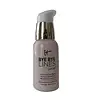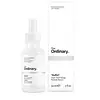What's inside
What's inside
 Key Ingredients
Key Ingredients

 Benefits
Benefits

 Concerns
Concerns

 Ingredients Side-by-side
Ingredients Side-by-side

Water
Skin ConditioningCyclopentasiloxane
EmollientCyclotetrasiloxane
EmollientDimethicone
EmollientIsododecane
EmollientVinyl Dimethicone/Methicone Silsesquioxane Crosspolymer
Glycerin
HumectantDimethicone/Vinyl Dimethicone Crosspolymer
Skin ConditioningHexyl Laurate
EmollientCyclohexasiloxane
EmollientOzokerite
Emulsion StabilisingPEG-10 Dimethicone
Skin ConditioningPetrolatum
EmollientSodium Chloride
MaskingCaprylyl Methicone
Skin ConditioningCetyl PEG/PPG-10/1 Dimethicone
EmulsifyingPolyglyceryl-4 Isostearate
EmulsifyingPolymethylsilsesquioxane
Polysilicone-11
Caprylyl Glycol
EmollientEthylhexylglycerin
Skin ConditioningSorbitan Olivate
Emulsifying1,2-Hexanediol
Skin ConditioningButylene Glycol
HumectantDisodium EDTA
Propylene Glycol
HumectantVitis Vinifera Seed Oil
EmollientUbiquinone
AntioxidantSqualane
EmollientSimmondsia Chinensis Seed Oil
EmollientSea Water
HumectantPunica Granatum Seed Oil
EmollientPersea Gratissima Oil
Skin ConditioningOrbignya Oleifera Seed Oil
EmollientNiacinamide
SmoothingMangifera Indica Seed Butter
Skin ConditioningCoffea Arabica Seed Extract
MaskingCitrus Aurantium Dulcis Oil
MaskingCitrus Grandis Peel Oil
MaskingCaffeine
Skin ConditioningArgania Spinosa Kernel Oil
EmollientArbutin
AntioxidantAdenosine
Skin ConditioningAnthemis Nobilis Flower Water
MaskingLactobacillus
Skin ConditioningIllite
AbrasiveBetula Platyphylla Japonica Juice
Skin ConditioningPerfluorohexane
SolventHibiscus Sabdariffa Flower Extract
Skin ConditioningCaviar Extract
Skin ConditioningSnail Secretion Filtrate
Skin ConditioningOlea Europaea Leaf Extract
PerfumingCucumis Sativus Fruit Extract
EmollientCamellia Sinensis Leaf Extract
AntimicrobialChrysanthemum Indicum Flower Extract
Skin ConditioningCholesteryl Chloride
Skin ConditioningCholesteryl Isostearate
EmollientCholesteryl Nonanoate
EmollientAlcohol
AntimicrobialArnica Montana Flower Extract
MaskingAlchemilla Vulgaris Extract
AstringentAnanas Sativus Fruit Extract
Skin ConditioningActinidia Chinensis Fruit Extract
EmollientPueraria Lobata Root Extract
HumectantPerfluorodecalin
Skin ConditioningMorus Alba Fruit Extract
AntioxidantMagnolia Kobus Bark Extract
Skin ConditioningGlycine Soja Sprout Extract
EmollientDiospyros Kaki Leaf Extract
Skin ProtectingCinnamomum Cassia Bark Extract
MaskingArtemisia Princeps Leaf Extract
Skin ConditioningPentafluoropropane
MaskingCurcuma Longa Root Extract
MaskingAchillea Millefolium Extract
CleansingSteareth-20
CleansingMarrubium Vulgare Extract
Skin ConditioningPhenoxyethanol
PreservativeGentiana Lutea Root Extract
Skin ConditioningArtemisia Absinthium Extract
Skin ConditioningHydrogenated Lecithin
EmulsifyingVeronica Officinalis Extract
Skin ConditioningPrimula Veris Extract
Skin ConditioningMentha Piperita Leaf Extract
Skin ConditioningMelissa Officinalis Leaf Extract
Skin ConditioningMalva Sylvestris Extract
AstringentHydrolyzed Hyaluronic Acid
HumectantColloidal Oatmeal
AbsorbentHydrolyzed Silk
HumectantCitric Acid
BufferingPotassium Sorbate
PreservativeSodium Benzoate
MaskingAlgae Extract
EmollientAloe Barbadensis Leaf Extract
EmollientN-Hydroxysuccinimide
Skin ConditioningHydrolyzed Collagen
EmollientCaprylhydroxamic Acid
Tocopherol
AntioxidantThiamine Hcl
MaskingRiboflavin
Cosmetic ColorantRetinyl Palmitate
Skin ConditioningPantothenic Acid
Skin ConditioningPalmitoyl Oligopeptide
CleansingNiacin
SmoothingFolic Acid
Skin ConditioningChrysin
Skin ConditioningCarnitine Hcl
HumectantBiotin
AntiseborrhoeicAscorbic Acid
AntioxidantPalmitoyl Tetrapeptide-7
Skin ConditioningChlorhexidine Digluconate
AntimicrobialCI 77891
Cosmetic ColorantMica
Cosmetic ColorantWater, Cyclopentasiloxane, Cyclotetrasiloxane, Dimethicone, Isododecane, Vinyl Dimethicone/Methicone Silsesquioxane Crosspolymer, Glycerin, Dimethicone/Vinyl Dimethicone Crosspolymer, Hexyl Laurate, Cyclohexasiloxane, Ozokerite, PEG-10 Dimethicone, Petrolatum, Sodium Chloride, Caprylyl Methicone, Cetyl PEG/PPG-10/1 Dimethicone, Polyglyceryl-4 Isostearate, Polymethylsilsesquioxane, Polysilicone-11, Caprylyl Glycol, Ethylhexylglycerin, Sorbitan Olivate, 1,2-Hexanediol, Butylene Glycol, Disodium EDTA, Propylene Glycol, Vitis Vinifera Seed Oil, Ubiquinone, Squalane, Simmondsia Chinensis Seed Oil, Sea Water, Punica Granatum Seed Oil, Persea Gratissima Oil, Orbignya Oleifera Seed Oil, Niacinamide, Mangifera Indica Seed Butter, Coffea Arabica Seed Extract, Citrus Aurantium Dulcis Oil, Citrus Grandis Peel Oil, Caffeine, Argania Spinosa Kernel Oil, Arbutin, Adenosine, Anthemis Nobilis Flower Water, Lactobacillus, Illite, Betula Platyphylla Japonica Juice, Perfluorohexane, Hibiscus Sabdariffa Flower Extract, Caviar Extract, Snail Secretion Filtrate, Olea Europaea Leaf Extract, Cucumis Sativus Fruit Extract, Camellia Sinensis Leaf Extract, Chrysanthemum Indicum Flower Extract, Cholesteryl Chloride, Cholesteryl Isostearate, Cholesteryl Nonanoate, Alcohol, Arnica Montana Flower Extract, Alchemilla Vulgaris Extract, Ananas Sativus Fruit Extract, Actinidia Chinensis Fruit Extract, Pueraria Lobata Root Extract, Perfluorodecalin, Morus Alba Fruit Extract, Magnolia Kobus Bark Extract, Glycine Soja Sprout Extract, Diospyros Kaki Leaf Extract, Cinnamomum Cassia Bark Extract, Artemisia Princeps Leaf Extract, Pentafluoropropane, Curcuma Longa Root Extract, Achillea Millefolium Extract, Steareth-20, Marrubium Vulgare Extract, Phenoxyethanol, Gentiana Lutea Root Extract, Artemisia Absinthium Extract, Hydrogenated Lecithin, Veronica Officinalis Extract, Primula Veris Extract, Mentha Piperita Leaf Extract, Melissa Officinalis Leaf Extract, Malva Sylvestris Extract, Hydrolyzed Hyaluronic Acid, Colloidal Oatmeal, Hydrolyzed Silk, Citric Acid, Potassium Sorbate, Sodium Benzoate, Algae Extract, Aloe Barbadensis Leaf Extract, N-Hydroxysuccinimide, Hydrolyzed Collagen, Caprylhydroxamic Acid, Tocopherol, Thiamine Hcl, Riboflavin, Retinyl Palmitate, Pantothenic Acid, Palmitoyl Oligopeptide, Niacin, Folic Acid, Chrysin, Carnitine Hcl, Biotin, Ascorbic Acid, Palmitoyl Tetrapeptide-7, Chlorhexidine Digluconate, CI 77891, Mica
Water
Skin ConditioningGlycerin
HumectantLactococcus Ferment Lysate
Skin ConditioningAcetyl Hexapeptide-8
HumectantPentapeptide-18
Skin ConditioningPalmitoyl Tripeptide-1
Skin ConditioningPalmitoyl Tetrapeptide-7
Skin ConditioningPalmitoyl Tripeptide-38
Skin ConditioningDipeptide Diaminobutyroyl Benzylamide Diacetate
Skin ConditioningAcetylarginyltryptophyl Diphenylglycine
Skin ConditioningSodium Hyaluronate Crosspolymer
HumectantSodium Hyaluronate
HumectantAllantoin
Skin ConditioningGlycine
BufferingAlanine
MaskingSerine
MaskingValine
MaskingIsoleucine
Skin ConditioningProline
Skin ConditioningThreonine
Histidine
HumectantPhenylalanine
MaskingArginine
MaskingAspartic Acid
MaskingTrehalose
HumectantFructose
HumectantGlucose
HumectantMaltose
MaskingUrea
BufferingSodium PCA
HumectantPCA
HumectantSodium Lactate
BufferingCitric Acid
BufferingHydroxypropyl Cyclodextrin
MaskingSodium Chloride
MaskingSodium Hydroxide
BufferingButylene Glycol
HumectantPentylene Glycol
Skin ConditioningAcacia Senegal Gum
MaskingXanthan Gum
EmulsifyingCarbomer
Emulsion StabilisingPolysorbate 20
EmulsifyingPPG-26-Buteth-26
Skin ConditioningPEG-40 Hydrogenated Castor Oil
EmulsifyingTrisodium Ethylenediamine Disuccinate
Ethoxydiglycol
HumectantSodium Benzoate
MaskingCaprylyl Glycol
EmollientEthylhexylglycerin
Skin ConditioningPhenoxyethanol
PreservativeChlorphenesin
AntimicrobialWater, Glycerin, Lactococcus Ferment Lysate, Acetyl Hexapeptide-8, Pentapeptide-18, Palmitoyl Tripeptide-1, Palmitoyl Tetrapeptide-7, Palmitoyl Tripeptide-38, Dipeptide Diaminobutyroyl Benzylamide Diacetate, Acetylarginyltryptophyl Diphenylglycine, Sodium Hyaluronate Crosspolymer, Sodium Hyaluronate, Allantoin, Glycine, Alanine, Serine, Valine, Isoleucine, Proline, Threonine, Histidine, Phenylalanine, Arginine, Aspartic Acid, Trehalose, Fructose, Glucose, Maltose, Urea, Sodium PCA, PCA, Sodium Lactate, Citric Acid, Hydroxypropyl Cyclodextrin, Sodium Chloride, Sodium Hydroxide, Butylene Glycol, Pentylene Glycol, Acacia Senegal Gum, Xanthan Gum, Carbomer, Polysorbate 20, PPG-26-Buteth-26, PEG-40 Hydrogenated Castor Oil, Trisodium Ethylenediamine Disuccinate, Ethoxydiglycol, Sodium Benzoate, Caprylyl Glycol, Ethylhexylglycerin, Phenoxyethanol, Chlorphenesin
 Reviews
Reviews

Alternatives
Ingredients Explained
These ingredients are found in both products.
Ingredients higher up in an ingredient list are typically present in a larger amount.
Butylene Glycol (or BG) is used within cosmetic products for a few different reasons:
Overall, Butylene Glycol is a safe and well-rounded ingredient that works well with other ingredients.
Though this ingredient works well with most skin types, some people with sensitive skin may experience a reaction such as allergic rashes, closed comedones, or itchiness.
Learn more about Butylene GlycolCaprylyl Glycol is a humectant and emollient, meaning it attracts and preserves moisture.
It is a common ingredient in many products, especially those designed to hydrate skin. The primary benefits are retaining moisture, skin softening, and promoting a healthy skin barrier.
Though Caprylyl Glycol is an alcohol derived from fatty acids, it is not the kind that can dry out skin.
This ingredient is also used as a preservative to extend the life of products. It has slight antimicrobial properties.
Learn more about Caprylyl GlycolCitric Acid is an alpha hydroxy acid (AHA) naturally found in citrus fruits like oranges, lemons, and limes.
Like other AHAs, citric acid can exfoliate skin by breaking down the bonds that hold dead skin cells together. This helps reveal smoother and brighter skin underneath.
However, this exfoliating effect only happens at high concentrations (20%) which can be hard to find in cosmetic products.
Due to this, citric acid is usually included in small amounts as a pH adjuster. This helps keep products slightly more acidic and compatible with skin's natural pH.
In skincare formulas, citric acid can:
While it can provide some skin benefits, research shows lactic acid and glycolic acid are generally more effective and less irritating exfoliants.
Most citric acid used in skincare today is made by fermenting sugars (usually from molasses). This synthetic version is identical to the natural citrus form but easier to stabilize and use in formulations.
Read more about some other popular AHA's here:
Learn more about Citric AcidEthylhexylglycerin (we can't pronounce this either) is commonly used as a preservative and skin softener. It is derived from glyceryl.
You might see Ethylhexylglycerin often paired with other preservatives such as phenoxyethanol. Ethylhexylglycerin has been found to increase the effectiveness of these other preservatives.
Glycerin is already naturally found in your skin. It helps moisturize and protect your skin.
A study from 2016 found glycerin to be more effective as a humectant than AHAs and hyaluronic acid.
As a humectant, it helps the skin stay hydrated by pulling moisture to your skin. The low molecular weight of glycerin allows it to pull moisture into the deeper layers of your skin.
Hydrated skin improves your skin barrier; Your skin barrier helps protect against irritants and bacteria.
Glycerin has also been found to have antimicrobial and antiviral properties. Due to these properties, glycerin is often used in wound and burn treatments.
In cosmetics, glycerin is usually derived from plants such as soybean or palm. However, it can also be sourced from animals, such as tallow or animal fat.
This ingredient is organic, colorless, odorless, and non-toxic.
Glycerin is the name for this ingredient in American English. British English uses Glycerol/Glycerine.
Learn more about GlycerinPalmitoyl Tetrapeptide-7 (formerly Palmitoyl Tetrapeptide-3) is a lab-made peptide with anti-inflammatory and skin-repairing benefits. It's made up of four amino acids (glycine, glutamine, proline, and arginine) and palmitic acid (which helps it penetrate skin more effectively).
This ingredient helps reduce inflammation by limiting the production of interleukin-6 (IL-6), a chemical that triggers inflammatory responses, particularly after UV exposure.
Less inflammation = slower collagen breakdown and a longer-lasting, youthful appearance.
Palmitoyl Tetrapeptide-7 also stimulates collagen production and supports a healthier skin barrier.
Over time, this can improve skin firmness, hydration, and reduce the appearance of fine lines. It’s commonly paired with Palmitoyl Tripeptide-1 in the well-known Matrixyl 3000 complex for enhanced anti-aging effects.
This ingredient has been shown to be effective and safe in cosmetic use and you'll typically find it in small amounts (less than 0.01%).
Due to its palmitic acid base, it may not be safe for Malassezia folliculitis.
Read more about other common types of peptides here:
Learn more about Palmitoyl Tetrapeptide-7Phenoxyethanol is a preservative that has germicide, antimicrobial, and aromatic properties. Studies show that phenoxyethanol can prevent microbial growth. By itself, it has a scent that is similar to that of a rose.
It's often used in formulations along with Caprylyl Glycol to preserve the shelf life of products.
Sodium Benzoate is a preservative. It's used in both cosmetic and food products to inhibit the growth of mold and bacteria. It is typically produced synthetically.
Both the US FDA and EU Health Committee have approved the use of sodium benzoate. In the US, levels of 0.1% (of the total product) are allowed.
Sodium benzoate works as a preservative by inhibiting the growth of bacteria inside of cells. It prevents the cell from fermenting a type of sugar using an enzyme called phosphofructokinase.
It is the salt of benzoic acid. Foods containing sodium benzoate include soda, salad dressings, condiments, fruit juices, wines, and snack foods.
Studies for using ascorbic acid and sodium benzoate in cosmetics are lacking, especially in skincare routines with multiple steps.
We always recommend speaking with a professional, such as a dermatologist, if you have any concerns.
Learn more about Sodium BenzoateChances are, you eat sodium chloride every day. Sodium Chloride is also known as table salt.
This ingredient has many purposes in skincare: thickener, emulsifier, and exfoliator.
You'll most likely find this ingredient in cleansers where it is used to create a gel-like texture. As an emulsifier, it also prevents ingredients from separating.
There is much debate on whether this ingredient is comedogenic. The short answer - comedogenic ratings don't tell the whole story. Learn more about comegodenic ratings here.
The concensus about this ingredient causing acne seems to be divided. Research is needed to understand if this ingredient does cause acne.
Scrubs may use salt as the primary exfoliating ingredient.
Learn more about Sodium ChlorideWater. It's the most common cosmetic ingredient of all. You'll usually see it at the top of ingredient lists, meaning that it makes up the largest part of the product.
So why is it so popular? Water most often acts as a solvent - this means that it helps dissolve other ingredients into the formulation.
You'll also recognize water as that liquid we all need to stay alive. If you see this, drink a glass of water. Stay hydrated!
Learn more about Water